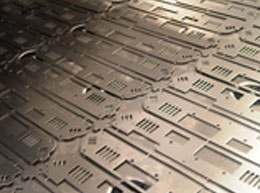
Radnest analyses the true shape, material and thickness of all components in a batch, separating and sorting automatically, producing high utilization, manufacturable nests from sheets, off-cuts and remnants delivering substantial savings in material and improving machine efficiency.
Radnest is a high performance true shape nester for punching and profiling machines supplementing the nesting utilities present in a standard Radan system, allowing the user to have full control over part placement and nest generation either manually, semi-automatically or fully automatically. Radnest can dramatically increase sheet utilization and significantly reduce the time taken to create nests..
Radnest allows 2D profiles to be imported on mass setting attributes such as material, thickness and quantity to be set as part of the quick and easy process, files can be cleaned and healed on import removing drawing borders, text and dimensions whilst closing small gaps and removing rogue geometry, preferences can be saved into templates allowing you to tailor your import to your customers data.
Kits can be created within Radan helping avoid parts being missed from assembly lists, enter into Radnest which kit you would like to manufacture and how many, Radnest will then explode the kit into its component parts with the correct materials, thicknesses and quantities.
When used with Radprofile, Radnest can automatically produce common line cuts between adjacent parts to further increase material utilization and reduce cycle time, gaps between components are controlled by the kerf width created by a given material, thickness and cutting method for a specific machine, this data is stored within Radan meaning that complete automation is possible. Radnest is able to mix different nesting techniques on the same sheet whether that means Rigid Kits, Picking Clusters, Common Cutting or Standard Spaced, the result is industry leading results for today's modern machinery and manufacturing techniques..
When Radnest is used with Radpunch, the tooling for each part is compared against the available stations in the turret or tool changer. This may restrict the orientations at which a part can be placed or mean that a different part is selected for the current nest. It is extremely important that the nest produced does not exceed the tooling capacity of the machine tool, as this would result in a program that could not be run. Radnest can analyse the geometry of punch tools used on parts enabling accurate spacing of components based on the distance between tool hits rather than the conventional part spacing, allowing parts to be nested closer together whilst still maintaining rigidity in the sheet and removing the danger of large external tools entering a neighbouring part.
Reading the data stored on Radan geometry is another way that Radnest improves the accuracy and reliability of nesting within an organization, Radan parts can have orientation restrictions, common cutting rules and removal data embedded onto them for any machine tool, Radnest is able to extract this data and use it in context based on the machine the nest is being created for. Radnest enables manufacturing flexibility that is unrivalled in our industry by using the information available to create the best manufacturable nest possible for any punching or profiling machine..
Radnest will keep track of components that have been nested and materials available. If the user decides that they do not want a nest for some reason they can just delete it prior to manufacture, any parts that were on the nest will return to the waiting list of parts and the material will return to the stock list. At any point the user can take manual control and place parts into a sheet or remnant, Radnest will keep a count of what has been done and modify the requirements accordingly. Manual placement of parts is interactive with Radnest keeping control of component spacing if required, simple functions like filling the free area of a sheet with stock or extra components can be accomplished easily either manually or automatically.
Radnest can place parts onto a sheet of any shape and areas of a specific sheet can be marked as unusable, whether that is because a component has been cut out or the sheet is defective for some reason. When nests are created that have an amount of free sheet remaining Radnest can automatically create a remnant, this remnant can be true shape being exactly the skeleton created, a rectangle trimmed to the last component on the nest or to a predetermined size in a range of sizes. Radnest will automatically store and use remnants as required with the user able to create bias helping to avoid the accumulation of remnants.
Radnest is a fast, modern nesting application designed and written by Radan to get the absolute best from available options whilst still allowing a human touch when required this is crucial in fast moving ever changing production environments. Radnest uses very modern and complex nesting algorithms to make decisions about parts being nested, the materials available and the machine running the program; to do this effectively it uses all of the computing power available, fully utilizing today's modern multicore processors to get the most cost efficient result in the shortest time.
By using Radnest you can expect to produce more components from less material in less time, the efficiencies gained have a significant effect on profit enabling you to manufacture parts from material that would have previously been in the scrap bin.



